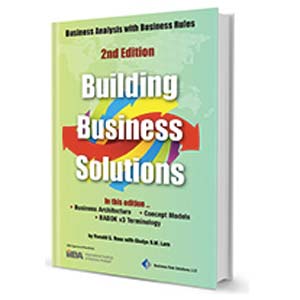Tracing the Path of Rule Reduction
| In this one-per-month special 'notepad' series, I am taking a quick look at important issues facing practitioners who are seeking to understand and apply the business rule approach for capturing business requirements and developing business systems. |
In last month's column, we discussed the difference between decomposition of processes vs. reduction of the business logic expressed in rules. In this month's column, we take a closer look at rule or logic reduction itself.[1]
Business Rule Solutions (BRS) broadly categorizes rules into governing rules, operating rules, and automated rules. Traceability for business logic results when information about the 'what, how, where, who, when, and why' of rule reduction from one level to the next is retained in an organized manner (e.g., in a rule repository).
- Governing Rules tend to be high-level directives with broad applicability
-- for example, Thou shalt not steal. In business, such rules are often
called policies. On their own, governing rules are usually not directly
actionable. (For example, what is the meaning of 'steal' and how does that
interpretation apply in various specific circumstances?) Nonetheless, they
do (or should) govern all actions in a general way.
- Operating Rules are interpreted from governing rules. An operating
rule must be actionable -- that is within the specific context(s) to which
it applies, it should provide unambiguous guidance. For example in context
of settlement activity, an operating rule might be: The amount settled for
an item on an order must be equal to the amount ordered for that item.
- Automated Rules are representations of rules in a form that a computer (e.g., rule engine, 3GL, etc.) can directly evaluate. They are the 'coded' counterparts of operating rules, sometimes having gone through significant translation and/or re-composition to satisfy the syntax understood by the given class of platform.
What are the linguistic properties of governing rules? Since we are not likely to have much luck reinventing the language of lawyers, politicians, regulators, or CEOs and other company managers, this should probably be considered outside our control.
What about the linguistic properties of operating rules? In RuleSpeakô, a rule statement must include one of the keywords must or only. Everything else in the rule statement (except for articles to increase readability and quantifiers of various kinds) are explicit fact statements from the associated fact model (i.e., structured business vocabulary).
Let me clarify what I mean above when I say an operating rule must be actionable. It literally means that a worker can read it and know how to act in a given situation. I do not mean that the operating rule could necessarily be understood in the context of a knowledge/record-keeping system. (Translation to that format should happen eventually -- sometime during system design -- but this is not the discriminator for operating rules.)
I definitely do not mean that the operating rule could be understood (i.e., evaluated or interpreted) by any kind of hardware/software platform! That would put things into the realm of class of platform -- that is, models for automation -- and that's nothing you should be worrying about for either the business model (Zachman row 2) or system model (Zachman row 3)!
References
[1] Acks to Stan Hendryx for his input to this column. ![]()
# # #
About our Contributor:
Online Interactive Training Series
In response to a great many requests, Business Rule Solutions now offers at-a-distance learning options. No travel, no backlogs, no hassles. Same great instructors, but with schedules, content and pricing designed to meet the special needs of busy professionals.











How to Define Business Terms in Plain English: A Primer
How to Use DecisionSpeak™ and Question Charts (Q-Charts™)
Decision Tables - A Primer: How to Use TableSpeak™
Tabulation of Lists in RuleSpeak®: A Primer - Using "The Following" Clause
Business Agility Manifesto
Business Rules Manifesto
Business Motivation Model
Decision Vocabulary
[Download]
[Download]
Semantics of Business Vocabulary and Business Rules